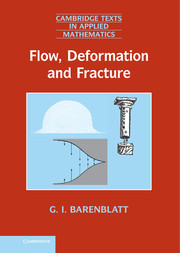 Flow, Deformation and Fracture
Flow, Deformation and Fracture Book contents
- Frontmatter
- Dedication
- Contents
- Foreword
- Preface
- Introduction
- 1 Idealized continuous media: the basic concepts
- 2 Dimensional analysis and physical similitude
- 3 The ideal incompressible fluid approximation: general concepts and relations
- 4 The ideal incompressible fluid approximation: analysis and applications
- 5 The linear elastic solid approximation. Basic equations and boundary value problems in the linear theory of elasticity
- 6 The linear elastic solid approximation. Applications: brittle and quasi-brittle fracture; strength of structures
- 7 The Newtonian viscous fluid approximation. General comments and basic relations
- 8 The Newtonian viscous fluid approximation. Applications: the boundary layer
- 9 Advanced similarity methods: complete and incomplete similarity
- 10 The ideal gas approximation. Sound waves; shock waves
- 11 Turbulence: generalities; scaling laws for shear flows
- 12 Turbulence: mathematical models of turbulent shear flows and of the local structure of turbulent flows at very large Reynolds numbers
- References
- Index
1 - Idealized continuous media: the basic concepts
Published online by Cambridge University Press: 05 June 2014
- Frontmatter
- Dedication
- Contents
- Foreword
- Preface
- Introduction
- 1 Idealized continuous media: the basic concepts
- 2 Dimensional analysis and physical similitude
- 3 The ideal incompressible fluid approximation: general concepts and relations
- 4 The ideal incompressible fluid approximation: analysis and applications
- 5 The linear elastic solid approximation. Basic equations and boundary value problems in the linear theory of elasticity
- 6 The linear elastic solid approximation. Applications: brittle and quasi-brittle fracture; strength of structures
- 7 The Newtonian viscous fluid approximation. General comments and basic relations
- 8 The Newtonian viscous fluid approximation. Applications: the boundary layer
- 9 Advanced similarity methods: complete and incomplete similarity
- 10 The ideal gas approximation. Sound waves; shock waves
- 11 Turbulence: generalities; scaling laws for shear flows
- 12 Turbulence: mathematical models of turbulent shear flows and of the local structure of turbulent flows at very large Reynolds numbers
- References
- Index
Summary
The idealized model of a continuous medium
In the mechanics of continua the most important invention (whose fundamental value, however, is not always appreciated because it seems so natural) is the very concept of a continuous modeling of real materials. More precisely, the truly fundamental discovery was recognizing that to a knowable degree of accuracy the motion, deformation, fracture and/or equilibrium of real bodies can be based on an idealization (a model), that of a continuous medium.
In fact, we intend to study, i.e. to make models of, the motions, deformations, flows, fracture etc. of real bodies. These bodies consist of specific materials: honey, milk, petroleum, metals, polymers, ceramics, rocks, composites etc. If we look at these materials with the naked eye they very often seem continuous and homogeneous. But, when viewed through a microscope or telescope these materials (see Figures 1.1–1.7) display a developed microstructure at various scales – from atomic to essentially macroscopic ones – having a huge diversity of shape. How can we account for this diversity of shapes and properties of the elements of microstructures? Let us forget for the moment that we do not know the equations governing the equilibrium or motion. We do know, however, that taking into account the shape of the elements of a microstructure should mean accepting certain conditions at the boundaries of these odd formations. Let us imagine that by some miracle we know all these odd shapes. It is easy to show that it is impossible to write down the conditions at the boundaries of the microstructural elements even for the simplest problems.
- Type
- Chapter
- Information
- Flow, Deformation and FractureLectures on Fluid Mechanics and the Mechanics of Deformable Solids for Mathematicians and Physicists, pp. 10 - 28Publisher: Cambridge University PressPrint publication year: 2014
